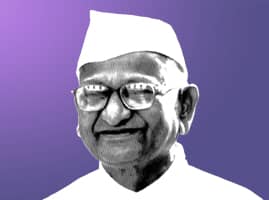The Lokpal Bill, a landmark piece of legislation in India, symbolizes a significant step towards combating corruption and enhancing accountability within the country’s political sphere.
Jan Lokpal, an independent anti-corruption ombudsman, has played a significant role in India’s public administration, tackling rampant corruption and establishing a national-level anti-corruption ombudsman, thereby transforming India’s governance landscape.

The Jan Lokpal movement, also known as the anti-corruption movement, has played a significant role in India’s battle against rampant corruption in its public administration. Initiated by social activist Anna Hazare in 2011, the movement aimed to establish an independent anti-corruption ombudsman called the Jan Lokpal at the national level.
This article delves into the background, key features, impact, and legacy of the Jan Lokpal movement, highlighting its importance in shaping India’s governance landscape.
The key features of the Jan Lokpal Bill:
Independence: The Jan Lokpal was envisioned as an autonomous body, free from political interference, with the power to initiate inquiries and take action against corruption.
Investigative Powers: The bill granted Jan Lokpal the authority to conduct investigations and inquiries, including the power to summon witnesses and gather evidence.
Prosecution and Judicial Powers: The Jan Lokpal would have the authority to initiate criminal proceedings against the accused, leading to their trial in special courts established for speedy disposal of corruption cases.
Impact and Achievements:
The Jan Lokpal movement garnered widespread support and sparked a nationwide debate on corruption. Thousands of Indians, including activists, students, and ordinary citizens, joined Hazare in his hunger strikes and peaceful protests, demanding a more transparent and accountable system. The movement’s impact can be seen through various achievements:
The movement’s impact can be seen through various achievements:
- Public Awareness: The movement created awareness about rampant corruption and the need for systemic reforms, leading to increased public consciousness regarding the detrimental effects of corruption.
- Legislative Focus: The movement compelled the government to prioritize anti-corruption legislation, putting pressure on policymakers to take action.
- Policy Reforms: Although the Jan Lokpal Bill itself has not been enacted at the national level, the movement influenced the government to introduce the Lokpal and Lokayuktas Act, 2013, which established Lokpal and Lokayuktas (anti-corruption ombudsman) at the central and state levels, respectively.
What were the challenges faced during the Jan Lokpal movement?
The Jan Lokpal movement encountered several challenges during its course:
- Government Resistance: The Indian government was initially resistant to the idea of an independent anti-corruption body. Political leaders were apprehensive about relinquishing control over investigations and prosecutions.
- Legal Hurdles: Drafting a robust and legally sound Jan Lokpal Bill was a complex task. Balancing the powers of the ombudsman with constitutional provisions and existing laws posed challenges.
- Public Mobilization: While the movement gained momentum, sustaining public interest and participation was challenging. Keeping citizens engaged and committed requires continuous efforts.
- Media Scrutiny: The movement faced intense scrutiny from the media. Balancing accurate reporting with sensationalism was crucial to maintaining credibility.
- Diverse Stakeholders: Coordinating efforts among diverse stakeholders—activists, students, and ordinary citizens—was not always seamless. Managing differing opinions and expectations was a challenge.
Despite these obstacles, the Jan Lokpal movement succeeded in raising awareness about corruption and pushing for systemic reforms in India’s political landscape.
How did Anna Hazare’s leadership impact the movement?
Anna Hazare, a resolute social activist, played a pivotal role in shaping the Jan Lokpal movement. His leadership left an indelible mark on the movement’s trajectory:
- Inspiring Symbol: Anna Hazare emerged as an inspiring symbol of unwavering commitment to the cause. His fasts unto death garnered attention and compelled people to rally behind the movement.
- Moral Authority: Hazare’s integrity and simplicity lent moral authority to the movement. His sacrifices resonated with the masses, reinforcing their trust in the cause.
- Mass Mobilization: His ability to mobilize people was remarkable. Hazare’s call for action resonated across diverse sections of society, uniting citizens against corruption.
- Negotiation Skills: Hazare adeptly negotiated with the government, pushing for the Jan Lokpal Bill. His persistence forced policymakers to engage in dialogue.
- Media Savvy: Hazare leveraged media effectively. His hunger strikes, speeches, and public addresses reached millions, amplifying the movement’s impact.
In essence, Anna Hazare’s leadership transformed the Jan Lokpal movement from an idea into a nationwide awakening, igniting hope for a more transparent and accountable India.
What were the key demands of Anna Hazare during his hunger strikes?
During his hunger strikes, Anna Hazare had several key demands:
- Setting up of the Lokpal at the center: The Jan Lokpal Bill, also known as the Citizen’s Ombudsman Bill, aimed to establish an independent body—the Jan Lokpal—that would investigate corruption cases, complete investigations within a year, and ensure trials concluded within the subsequent year.
- Lokayuktas in the states: The Lokayuktas are anti-corruption ombudsman organizations at the state level. Once appointed, they cannot be dismissed or transferred by the government and can only be removed through an impeachment motion by the state assembly.
- Implementation of the Swaminathan Commission report: This report, chaired by Professor MS Swaminathan, focused on addressing farmer distress and rising farmer suicides.
Who is Anna Hazare?

Anna Hazare, born Kisan Baburao Hazare, is an Indian social activist and a prominent figure in the fight against corruption. His tireless efforts have made a significant impact on Indian society. Here are some key points about him:
- Background and Early Life:
• Anna Hazare was born on June 15, 1937, in Bhingar, a small village in Maharashtra, India.
• He served in the Indian Army for 15 years before retiring as a junior commissioned officer.
- Anti-Corruption Movement:
• Anna Hazare gained widespread recognition during his anti-corruption movement
in 2011.
• He led a hunger strike demanding the establishment of a Lokpal (an independent ombudsman) to investigate corruption cases at the central level.
• His movement garnered immense public support and put pressure on the government to take action. - Key Demands:
• Anna Hazare’s primary demands during his hunger strikes included:
• Setting up a Lokpal at the center.
• Establishing Lokayuktas (state-level anti-corruption bodies) in various
states.
• Implementing the Swaminathan Commission report to address farmer distress and fair pay for farmers. - Legacy and Impact:
• His activism inspired millions of Indians to raise their voices against corruption.
• Although the Lokpal bill was eventually passed, its effectiveness remains a topic of
debate.
• Anna Hazare’s commitment to transparency, accountability, and social justice continues to resonate with people.
In summary, Anna Hazare is a remarkable individual who has dedicated his life to fighting corruption and advocating for a more just and accountable society.
Did his movement lead to any policy changes?
Anna Hazare’s anti-corruption movement had a significant impact, leading to some policy changes in India. Here are the notable outcomes:
- Lokpal and Lokayuktas:
• As a result of the movement, the Lokpal and Lokayuktas Act was passed in 2013.
• The Lokpal is an independent ombudsman at the central level, responsible for
investigating corruption cases involving public officials.
• Lokayuktas were also established in various states to address corruption at the state level. - Increased Awareness and Public Pressure:
• Anna Hazare’s hunger strikes and public demonstrations raised awareness about corruption and the need for accountability.
• The movement put immense pressure on the government to take action against corruption.
- Debates and Challenges:
• While the Lokpal Act was a significant step, its effectiveness remains a subject of debate.
• Some argue that the Lokpal’s powers and independence need further strengthening. - Continued Advocacy:
• Anna Hazare’s legacy continues to inspire activists and citizens to fight against corruption.
• His movement highlighted the importance of citizen participation in shaping policies and holding authorities accountable.
In summary, Anna Hazare’s movement prompted policy changes, but ongoing efforts are necessary to ensure effective implementation and address corruption comprehensively.
What were the challenges in implementing the Lokpal Act?
The implementation of the Lokpal Act in India faced several challenges:
- Structural and Administrative Challenges:
• Composition of the Lokpal: Determining the composition, appointment process, and qualifications of Lokpal members was a complex task. Balancing independence with accountability was crucial.
• Jurisdiction: Defining the Lokpal’s jurisdiction—whether it should cover all public servants or only specific categories—was a contentious issue. - Operational Challenges:
• Investigative Powers: Ensuring that the Lokpal had adequate investigative powers to probe corruption cases effectively was challenging.
• Coordination with Existing Agencies: Coordinating with existing agencies like the Central Bureau of Investigation (CBI) and state anti-corruption bodies required careful planning. - Political Resistance and Delays:
• Political Will: The Lokpal Act faced resistance from politicians who were wary of increased scrutiny. Building consensus across party lines was difficult.
• Delays in Implementation: The process of drafting, debating, and passing the legislation took years. Implementation was further delayed due to administrative hurdles. - Public Expectations and Realities:
• High Expectations: The public had high expectations from the Lokpal, expecting it to swiftly tackle corruption cases. Meeting these expectations was challenging.
• Resource Constraints: Allocating sufficient resources for the Lokpal’s functioning was essential but posed budgetary challenges. - Legal and Constitutional Issues:
• Constitutional Validity: Some legal experts questioned the constitutional validity of certain provisions in the Lokpal Act.
• Judicial Review: The Act’s provisions were subject to judicial review, leading to debates on its legality.
Despite these challenges, the Lokpal Act represents a significant step toward transparency and accountability. However, ongoing efforts are needed to address its limitations and enhance its effectiveness.



